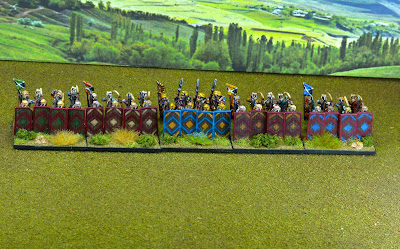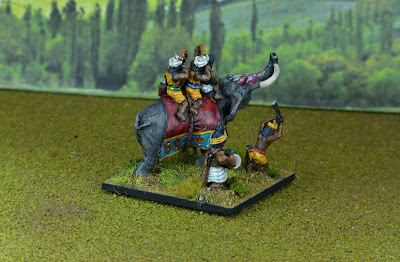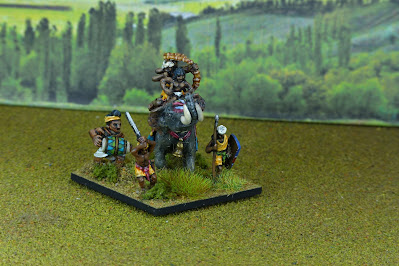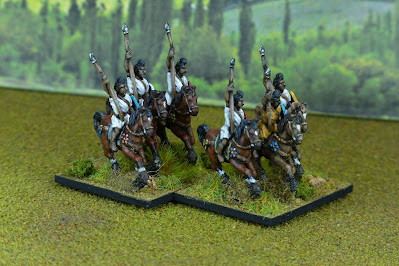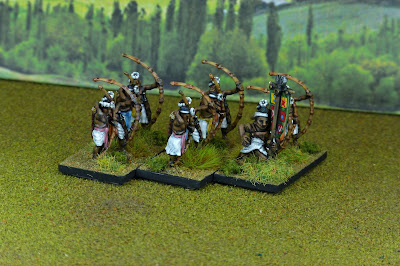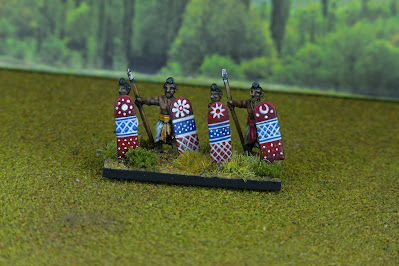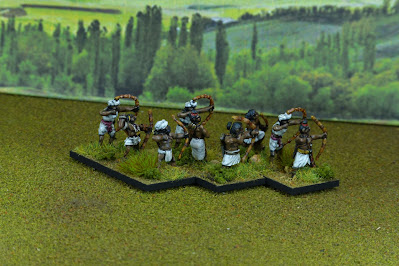Here’s my guide to painting Achaemenid Persian warriors, both early and later. Persian warriors are often depicted with quite complex patterns on their clothing. I’ve tried to simplify things.
When I painted my version of the early Achaemenid army, I made some basic sketches of the tunic and trouser designs that I saw in reference books. What I’ve done here is to make those sketches into simple graphics that are a little less rough and ready than the originals.
The style of these figures, with tiara headwear, tunic, trousers and low boots, is often described as “Median Dress” but it is just the universal costume for Iranian troops of the time.
Iranian infantry and cavalry wore identical clothing.
The tunics and trousers designs are identical front and rear. The headgear is assumed to be the soft felt hat that was tied variously and usually called a tiara. Footwear is a low cut boot or shoe.
When worn, armour would be an iron scale cuirass with iron or bronze helmets.
The Elites: Immortals etc
This first section details the costumes of the Persian elite troops. The Immortals are the most famous Achaemenid Persian unit, but there were others, both foot and mounted. The names ascribed to these units include Apple Bearers, Kinsmen and Royal Guard.
These sources indicate that the Immortals and other guard units, probably wore uniforms.
Tunics:
Elite units received grants of expensive coloured cloth. Thus, there is a lot of purples and bright yellows.
Most of the tunics depicted below are slightly simplified versions of the designs from Nick Secunda’s Osprey publication, The Persian Army 560-330BC.
He based these reconstructions on the Alexander Sarcophagus, as well as on hints from various writers, including Xenophon, Curtius, Phylarchus and Athenaeus.
Trousers:
Tunics that are paired with trousers are as they are shown in the sources, otherwise refer to the section on trousers below for ideas.
Tiaras:
The tiaras of these elite units are often depicted as bright yellow. This probably was not universal, white and other colours were no doubt used. However I stuck to bright yellows for my elite units.
Footwear:
Footwear is usually depicted in light brown colours, as might be expected. However bright blue, red and yellows are seen on the Alexander Sarcophagus, so feel free to experiment.
Iranian Foot and cavalry
This section shows a range tunic designs that rank and file Iranian soldiers, both infantry and mounted wore. They also work well for Scythians.
Again, I’ve simplified the designs. Depictions of Persians Greek pottery, like the one below show very intricate patterns that I think are too complex for painting on 15mm figures. I’ve tried a few times and found the results weren’t worth the effort.
Tunics:
The patterns on these tunics are similar to those of the Elite troops above. Unlike those in the Elites section, the colours on these pictures are not from specific sources, so most colours are okay to use.
However, since these troops provided their own equipment, I would use slightly more muted tones and avoid purple altogether. Plain tunics are fine too (but just don’t feel Persian!)
For earlier Achaemenids, you could certainly add coloured dots to the designs. I found a line of dots running beside stripes, like the tunic on the bottom left of the group, worked well.
If you really want to go to town on any figures, standard bearers, like this one below, might be a good place.
Trousers:
Here is a range of designs for trousers. Keep in mind plain, trousers would be fine too. I found a chocolate brown with white patterning both looks good and is historical.
For what it’s worth, I think using slightly plain trousers can make the tunic designs pop more, so I’d tend to earthy colours for most trousers.
Tiaras:
I painted the tiaras for basic Iranian troops a variety of bone whites, muted yellows, and light beiges.
Footwear:
I stuck with basic light leather colours for these troops.
Here are some Bactrian foot.
Spara Shields:
The standard early Achaemenid Persian foot formation is described as having ten ranks. A front rank of Sparabara (shield bearers) backed up by nine ranks of archers. Spara were large rectangular shields of canes thrust through dyed leather. By using cutouts in the leather allowing the canes to show, the shields were quite patterned.
I gave all my sparabara the same pattern but varied the colour of the leather from one unit to the next. You could vary the colours and/or patterns from one soldier to the next, but that wasn’t to my taste.
The Kandys:
The kandys was a 3/4 length sleeved coat that Persian officers wore as a mark of their nobility. These would have been richly coloured and often had a coloured trim on the hem, lapels etc, as well on the sleeves.
If you like these posts, why not
"Like"
Wargrunt Art on Facebook for updates












